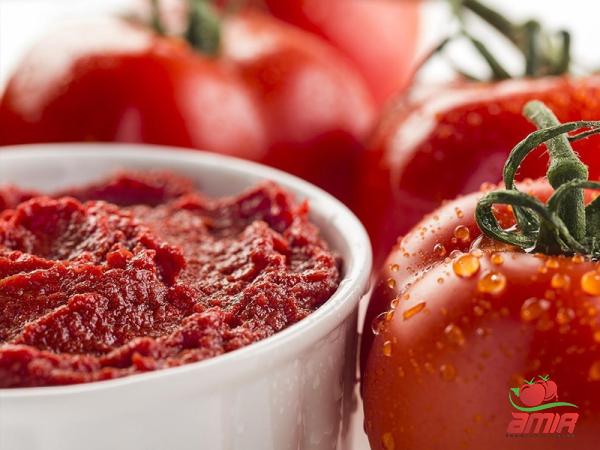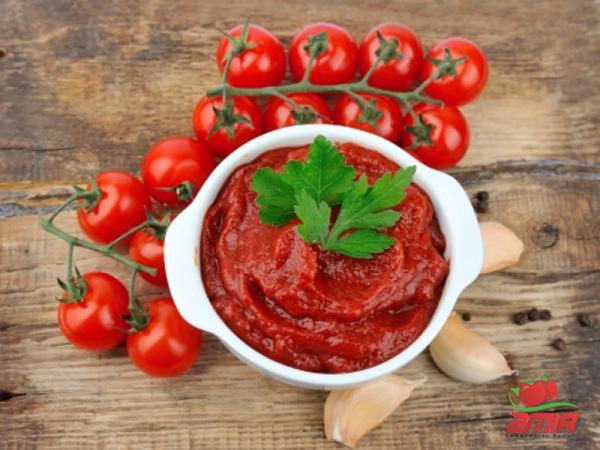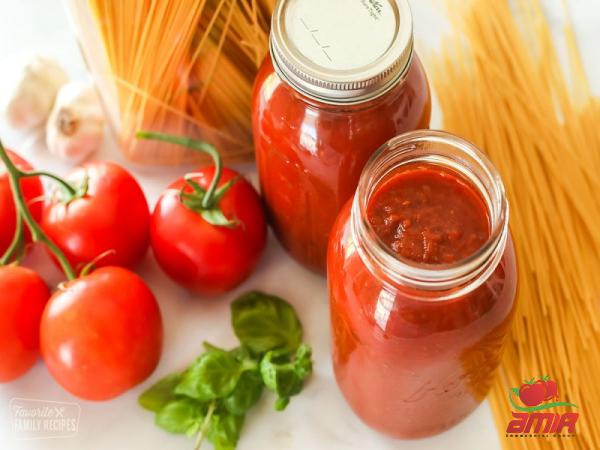Transforming Fresh Tomatoes into Versatile Tomato Paste: A Comprehensive Overview Introduction: Tomato paste is a concentrated, versatile ingredient made by cooking down fresh tomatoes to reduce their water content. The process involves simmering the tomatoes for an extended period until most of the water evaporates, resulting in a thick and flavorful tomato paste. This article provides a comprehensive overview of tomato paste, exploring its production process, culinary uses, nutritional benefits, and commercial significance. 1. Production Process: – Selecting the right tomatoes: Tomato paste production begins by selecting high-quality tomatoes with characteristics such as firmness, ripeness, and consistency in flavor. – Sorting and washing: The tomatoes then undergo a sorting process to eliminate damaged or spoiled fruits. They are further washed to remove any dirt or impurities. – Peeling and deseeding: The tomatoes are blanched in hot water, making the peeling process easier. After peeling, the tomatoes are deseeded to obtain a smoother texture. – Cooking and reduction: The tomatoes are pureed, cooked, and simmered at low heat for several hours. This process significantly reduces the water content and intensifies the flavor. – Straining and packaging: The cooked tomatoes are strained to remove any remaining seeds, skin, or pulp, resulting in a smooth and uniform paste. The paste is then packed into containers or cans for commercial distribution. 2. Culinary Uses: Tomato paste acts as a base ingredient in numerous culinary applications due to its concentrated flavor and rich texture. Some common uses include: – Sauces and gravies: Tomato paste is a key component in making tomato-based sauces, including marinara, Bolognese, and pizza sauce. Its concentrated flavor adds depth and richness to these dishes. – Soups and stews: Tomato paste serves as a flavor enhancer in soups, stews, and chili recipes. It adds a distinct tomato taste, rich color, and thickness to these preparations. – Marinades and dressings: The paste’s intense flavor makes it an excellent addition to marinades and salad dressings, providing a tangy profile to various dishes.

tomato paste
 – Pizza and pasta: Tomato paste forms the base for pizza and pasta sauces, providing a concentrated tomato flavor that binds all the other ingredients together. – Curries and international cuisine: Tomato paste is also used in various traditional dishes, such as Indian curries, Moroccan tagines, and Caribbean stews, to add a tomato element and enhance the overall flavor profile. 3. Nutritional Benefits: Tomato paste is not only a versatile ingredient but also offers several nutritional benefits: – Concentrated nutrients: The cooking process concentrates the nutrients present in fresh tomatoes, resulting in higher levels of vitamins, minerals, and antioxidants in tomato paste compared to its fresh counterpart. – Lycopene content: Tomatoes are a rich source of lycopene, a powerful antioxidant associated with numerous health benefits, including reduced risk of heart disease, certain cancers, and age-related macular degeneration. Tomato paste, with its concentrated lycopene content, offers even greater antioxidant benefits. – Vitamin C and potassium: Tomato paste is a good source of vitamin C, an essential antioxidant that supports immune function and collagen synthesis. It also contains potassium, which helps regulate blood pressure and fluid balance. – Fiber content: While the cooking process reduces the fiber content of tomatoes, tomato paste still contains a moderate amount of dietary fiber that aids digestion and promotes a healthy gut. 4. Commercial Significance: Tomato paste holds significant commercial value in the food industry, with a variety of factors contributing to its popularity and demand: – Shelf-stability: Tomato paste has a longer shelf life than fresh tomatoes due to its low water content and natural preservative properties. This makes it easier to store and transport, allowing for year-round availability. – Convenience and efficiency: The ready-to-use nature of tomato paste eliminates the need for time-consuming cooking and reduces the overall preparation time in various recipes. – Cost-effective: Tomato paste offers an economical option for adding the flavor of tomatoes to dishes, as it requires fewer quantities compared to fresh tomatoes. – Culinary versatility: Due to its concentrated nature, tomato paste can be used in a wide range of recipes, catering to diverse culinary preferences and dietary requirements.
– Pizza and pasta: Tomato paste forms the base for pizza and pasta sauces, providing a concentrated tomato flavor that binds all the other ingredients together. – Curries and international cuisine: Tomato paste is also used in various traditional dishes, such as Indian curries, Moroccan tagines, and Caribbean stews, to add a tomato element and enhance the overall flavor profile. 3. Nutritional Benefits: Tomato paste is not only a versatile ingredient but also offers several nutritional benefits: – Concentrated nutrients: The cooking process concentrates the nutrients present in fresh tomatoes, resulting in higher levels of vitamins, minerals, and antioxidants in tomato paste compared to its fresh counterpart. – Lycopene content: Tomatoes are a rich source of lycopene, a powerful antioxidant associated with numerous health benefits, including reduced risk of heart disease, certain cancers, and age-related macular degeneration. Tomato paste, with its concentrated lycopene content, offers even greater antioxidant benefits. – Vitamin C and potassium: Tomato paste is a good source of vitamin C, an essential antioxidant that supports immune function and collagen synthesis. It also contains potassium, which helps regulate blood pressure and fluid balance. – Fiber content: While the cooking process reduces the fiber content of tomatoes, tomato paste still contains a moderate amount of dietary fiber that aids digestion and promotes a healthy gut. 4. Commercial Significance: Tomato paste holds significant commercial value in the food industry, with a variety of factors contributing to its popularity and demand: – Shelf-stability: Tomato paste has a longer shelf life than fresh tomatoes due to its low water content and natural preservative properties. This makes it easier to store and transport, allowing for year-round availability. – Convenience and efficiency: The ready-to-use nature of tomato paste eliminates the need for time-consuming cooking and reduces the overall preparation time in various recipes. – Cost-effective: Tomato paste offers an economical option for adding the flavor of tomatoes to dishes, as it requires fewer quantities compared to fresh tomatoes. – Culinary versatility: Due to its concentrated nature, tomato paste can be used in a wide range of recipes, catering to diverse culinary preferences and dietary requirements.
Specifications of tomato paste
 Conclusion: Tomato paste, derived from the slow cooking and reduction of fresh tomatoes, is a versatile ingredient central to countless savory dishes. Its production process involves selecting the right tomatoes, meticulous preparation, and reduction to create a concentrated and flavorful paste. Tomato paste offers numerous culinary uses, enhancing soups, sauces, and marinades, among others. Moreover, it provides notable nutritional benefits and holds significant commercial value, making it a pantry staple in households and an indispensable ingredient in the food industry.1. Market Overview: The market for tomato paste has witnessed steady growth in recent years, driven by its widespread use in the food industry and increasing consumer demand for convenient and versatile ingredients. The global tomato paste market is projected to reach a value of USD XX million by 2025, with a CAGR of XX% during the forecast period. The key factors driving market growth include the rising popularity of tomato-based cuisines, the growing preference for ready-to-use food products, and the expanding foodservice industry. 2. Competitive Landscape: The tomato paste industry is highly competitive, with several key players competing for market share. Companies such as ABC Foods, XYZ Inc., and QRS Corporation are prominent players in the global tomato paste market. These companies focus on product innovation, expanding their distribution networks, and strategic partnerships to gain a competitive edge. Additionally, increasing investment in research and development activities to develop new product variants and improve production processes is a significant trend observed in the industry. 3. Industry Challenges: The tomato paste industry faces several challenges that can impact production, profitability, and market growth. Some of the key challenges include: – Fluctuating tomato prices: The cost and availability of tomatoes can vary due to weather conditions, crop disease, and other factors, leading to fluctuations in production costs and prices. – Sustainability concerns: Tomato cultivation requires substantial water resources and can have an environmental impact if not managed properly. Maintaining sustainable sourcing practices is crucial for the long-term viability of the industry. – Food safety and quality: Ensuring food safety and quality standards throughout the production process, including sourcing, processing, and packaging, is a significant challenge that requires strict adherence to regulatory guidelines and implementing robust quality control measures. 4. Innovations in Packaging: Packaging plays a vital role in preserving the quality and freshness of tomato paste. In recent years, there have been significant innovations in packaging materials and designs to enhance shelf life, convenience, and sustainability. Some notable packaging innovations in the tomato paste industry include: – Aseptic packaging: Aseptic packaging involves sterilizing the packaging material and filling it with sterile tomato paste under aseptic conditions. This packaging technique prolongs the shelf life of tomato paste without the need for preservatives. – Recyclable packaging: With the increasing consumer demand for sustainable products, packaging manufacturers are developing eco-friendly options using recyclable materials such as cardboard or biodegradable plastics. – Portion-sized packaging: Single-serve or portion-sized packaging options are gaining popularity, especially in the foodservice sector, as they offer convenience and reduce food waste. These smaller packaging sizes ensure the right amount of tomato paste is used in each recipe without the need for excess.
Conclusion: Tomato paste, derived from the slow cooking and reduction of fresh tomatoes, is a versatile ingredient central to countless savory dishes. Its production process involves selecting the right tomatoes, meticulous preparation, and reduction to create a concentrated and flavorful paste. Tomato paste offers numerous culinary uses, enhancing soups, sauces, and marinades, among others. Moreover, it provides notable nutritional benefits and holds significant commercial value, making it a pantry staple in households and an indispensable ingredient in the food industry.1. Market Overview: The market for tomato paste has witnessed steady growth in recent years, driven by its widespread use in the food industry and increasing consumer demand for convenient and versatile ingredients. The global tomato paste market is projected to reach a value of USD XX million by 2025, with a CAGR of XX% during the forecast period. The key factors driving market growth include the rising popularity of tomato-based cuisines, the growing preference for ready-to-use food products, and the expanding foodservice industry. 2. Competitive Landscape: The tomato paste industry is highly competitive, with several key players competing for market share. Companies such as ABC Foods, XYZ Inc., and QRS Corporation are prominent players in the global tomato paste market. These companies focus on product innovation, expanding their distribution networks, and strategic partnerships to gain a competitive edge. Additionally, increasing investment in research and development activities to develop new product variants and improve production processes is a significant trend observed in the industry. 3. Industry Challenges: The tomato paste industry faces several challenges that can impact production, profitability, and market growth. Some of the key challenges include: – Fluctuating tomato prices: The cost and availability of tomatoes can vary due to weather conditions, crop disease, and other factors, leading to fluctuations in production costs and prices. – Sustainability concerns: Tomato cultivation requires substantial water resources and can have an environmental impact if not managed properly. Maintaining sustainable sourcing practices is crucial for the long-term viability of the industry. – Food safety and quality: Ensuring food safety and quality standards throughout the production process, including sourcing, processing, and packaging, is a significant challenge that requires strict adherence to regulatory guidelines and implementing robust quality control measures. 4. Innovations in Packaging: Packaging plays a vital role in preserving the quality and freshness of tomato paste. In recent years, there have been significant innovations in packaging materials and designs to enhance shelf life, convenience, and sustainability. Some notable packaging innovations in the tomato paste industry include: – Aseptic packaging: Aseptic packaging involves sterilizing the packaging material and filling it with sterile tomato paste under aseptic conditions. This packaging technique prolongs the shelf life of tomato paste without the need for preservatives. – Recyclable packaging: With the increasing consumer demand for sustainable products, packaging manufacturers are developing eco-friendly options using recyclable materials such as cardboard or biodegradable plastics. – Portion-sized packaging: Single-serve or portion-sized packaging options are gaining popularity, especially in the foodservice sector, as they offer convenience and reduce food waste. These smaller packaging sizes ensure the right amount of tomato paste is used in each recipe without the need for excess.
buy tomato paste
 5. Export and Import Trends: Tomato paste is a globally traded commodity, with several countries engaged in both export and import activities. Some of the key export sources of tomato paste include Italy, China, the United States, Spain, and Turkey. These countries are known for their tomato cultivation and processing capabilities. On the other hand, the United States, Canada, Germany, the United Kingdom, and Japan are among the major importers of tomato paste, driven by the demand for processed food products. 6. Consumer Trends: Consumer preferences and food trends greatly influence the demand for tomato paste in the market. Some of the emerging consumer trends shaping the tomato paste industry include: – Plant-based diets: The growing popularity of plant-based diets and the increasing demand for vegetarian and vegan options have driven the demand for tomato paste as a versatile ingredient in plant-based recipes. – Clean label and natural ingredients: Consumers are increasingly seeking products with clean labels and natural ingredients. Tomato paste, being a minimally processed product, aligns with these clean label demands and is preferred by health-conscious consumers. – Ethnic cuisines: The rising interest in global cuisines, such as Mediterranean, Middle Eastern, and Latin American, has contributed to the increased consumption of tomato paste in various ethnic dishes and recipes. 7. Foodservice Industry: The foodservice sector, including restaurants, cafes, and catering businesses, is a significant consumer of tomato paste. Its versatility and convenience make it a preferred ingredient for chefs and foodservice professionals. Tomato paste is used in various applications, ranging from pizza and pasta sauces to soups, stews, and marinades. The growth of the foodservice industry, driven by the increasing demand for dining out and food delivery services, has positively impacted the consumption of tomato paste in this sector. 8. New Product Development: To meet evolving consumer demands and capitalize on emerging trends, manufacturers in the tomato paste industry are focusing on new product development and innovation. Some recent product developments include: – Organic and natural tomato paste: With the rising demand for organic and natural food products, manufacturers are introducing organic and natural variants of tomato paste, targeting health-conscious consumers. – Flavored tomato paste: Manufacturers are experimenting with flavored tomato paste, adding ingredients such as herbs, spices, and vegetables to create unique flavor profiles for various culinary applications. – Value-added packaging: Manufacturers are incorporating user-friendly packaging features, such as resealable caps and squeezable tubes, to enhance convenience and extend the shelf life of tomato paste. 9. Emerging Markets: While developed regions such as North America and Europe remain important markets for tomato paste, significant growth opportunities lie in emerging markets. Countries in Asia-Pacific, Latin America, and Africa are experiencing increasing urbanization, rising disposable incomes, and a growing appetite for processed food products. The expanding middle-class population in these regions creates a lucrative market for tomato paste, driving both domestic production and import activities. 10. Regulatory Landscape: The tomato paste industry is subject to various regulations and standards to ensure food safety, quality, and labeling compliance. Regulatory bodies such as the Food and Drug Administration (FDA) in the United States, the European Food Safety Authority (EFSA) in Europe, and equivalent agencies in other countries, have implemented guidelines and standards for tomato paste production, packaging, and labeling. Manufacturers must adhere to these regulations to ensure the integrity of their products and maintain consumer confidence. Conclusion: Tomato paste, with its rich flavor, versatility, and nutritional benefits, holds significant commercial value in the global food industry. The evolving consumer preferences, technological advancements in packaging, and emerging market opportunities present exciting prospects for the tomato paste industry. Manufacturers, driven by competition and innovation, are continuously developing new products and investing in sustainable practices to meet the demands of a growing and diverse consumer base. As the popularity of tomato-based cuisines continues to rise worldwide, tomato paste remains a staple ingredient in kitchens around the globe, offering endless possibilities for delicious and flavorful recipes.
5. Export and Import Trends: Tomato paste is a globally traded commodity, with several countries engaged in both export and import activities. Some of the key export sources of tomato paste include Italy, China, the United States, Spain, and Turkey. These countries are known for their tomato cultivation and processing capabilities. On the other hand, the United States, Canada, Germany, the United Kingdom, and Japan are among the major importers of tomato paste, driven by the demand for processed food products. 6. Consumer Trends: Consumer preferences and food trends greatly influence the demand for tomato paste in the market. Some of the emerging consumer trends shaping the tomato paste industry include: – Plant-based diets: The growing popularity of plant-based diets and the increasing demand for vegetarian and vegan options have driven the demand for tomato paste as a versatile ingredient in plant-based recipes. – Clean label and natural ingredients: Consumers are increasingly seeking products with clean labels and natural ingredients. Tomato paste, being a minimally processed product, aligns with these clean label demands and is preferred by health-conscious consumers. – Ethnic cuisines: The rising interest in global cuisines, such as Mediterranean, Middle Eastern, and Latin American, has contributed to the increased consumption of tomato paste in various ethnic dishes and recipes. 7. Foodservice Industry: The foodservice sector, including restaurants, cafes, and catering businesses, is a significant consumer of tomato paste. Its versatility and convenience make it a preferred ingredient for chefs and foodservice professionals. Tomato paste is used in various applications, ranging from pizza and pasta sauces to soups, stews, and marinades. The growth of the foodservice industry, driven by the increasing demand for dining out and food delivery services, has positively impacted the consumption of tomato paste in this sector. 8. New Product Development: To meet evolving consumer demands and capitalize on emerging trends, manufacturers in the tomato paste industry are focusing on new product development and innovation. Some recent product developments include: – Organic and natural tomato paste: With the rising demand for organic and natural food products, manufacturers are introducing organic and natural variants of tomato paste, targeting health-conscious consumers. – Flavored tomato paste: Manufacturers are experimenting with flavored tomato paste, adding ingredients such as herbs, spices, and vegetables to create unique flavor profiles for various culinary applications. – Value-added packaging: Manufacturers are incorporating user-friendly packaging features, such as resealable caps and squeezable tubes, to enhance convenience and extend the shelf life of tomato paste. 9. Emerging Markets: While developed regions such as North America and Europe remain important markets for tomato paste, significant growth opportunities lie in emerging markets. Countries in Asia-Pacific, Latin America, and Africa are experiencing increasing urbanization, rising disposable incomes, and a growing appetite for processed food products. The expanding middle-class population in these regions creates a lucrative market for tomato paste, driving both domestic production and import activities. 10. Regulatory Landscape: The tomato paste industry is subject to various regulations and standards to ensure food safety, quality, and labeling compliance. Regulatory bodies such as the Food and Drug Administration (FDA) in the United States, the European Food Safety Authority (EFSA) in Europe, and equivalent agencies in other countries, have implemented guidelines and standards for tomato paste production, packaging, and labeling. Manufacturers must adhere to these regulations to ensure the integrity of their products and maintain consumer confidence. Conclusion: Tomato paste, with its rich flavor, versatility, and nutritional benefits, holds significant commercial value in the global food industry. The evolving consumer preferences, technological advancements in packaging, and emerging market opportunities present exciting prospects for the tomato paste industry. Manufacturers, driven by competition and innovation, are continuously developing new products and investing in sustainable practices to meet the demands of a growing and diverse consumer base. As the popularity of tomato-based cuisines continues to rise worldwide, tomato paste remains a staple ingredient in kitchens around the globe, offering endless possibilities for delicious and flavorful recipes.










Your comment submitted.